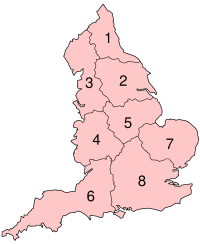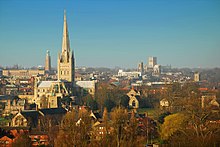East Anglia
This article needs additional citations for verification. (April 2016) |
East Anglia | ||
|---|---|---|
|
Country England | | |
| Region | East of England | |
| Ceremonial counties |
| |
East Anglia is an area in the East of England.[1] It comprises the counties of Norfolk and Suffolk and Cambridgeshire, with Essex also included in some definitions.[2][3] The name derives from the Anglo-Saxon kingdom of the East Angles, a people whose name originated in Anglia, in what is now Northern Germany.
Area
Definitions of what constitutes East Anglia vary. The


Other definitions of the area have been used or proposed over the years. For example, the
East Anglian cities Peterborough and Cambridge have consistently been on the U.K.'s fastest growing cities in both population and economy. Compared to the rest of the U.K., East Anglia alongside the East of England has the fastest growth by population in the country.
The largest city and urban area in East Anglia is Peterborough with an urban population of 215,673 and a total population of 217,705 as of Census 2021.
History
The kingdom of East Anglia initially consisted of
A 2016 study found that modern East Anglians share a strong genetic affinity with early medieval skeletons, but differ substantially from Iron Age and Roman era ones, which are more similar to the Welsh. This was taken to support a major influence of the Anglian migrations on the genetic makeup of East Anglia.[11] In a 2022 study by Joscha Gretzinger et al., the populations of Norfolk and Suffolk were found to be the group with the lowest amount of Iron Age/Roman period British Isles-related ancestry, with only about 11-17.5% of their ancestry being derived from that group, while having one of the highest amounts of Continental North European (43.8-50.7%), and the highest amount of Continental West European (32.2-43.1%) ancestry in all of England.[12]
East Anglia was the most powerful of the
Parts of East Anglia remained marshland until the 17th century drainage of the Fens, despite some earlier engineering work during the Roman occupation. The
During the
Geography



East Anglia is bordered to the north and east by the North Sea, to the south by the estuaries of the rivers Orwell and Stour, and shares an undefined land border to the west with the rest of England. Much of northern East Anglia is flat, low-lying and marshy (such as the Fens of Cambridgeshire and Norfolk), although the extensive drainage projects of the past centuries actually make this one of the driest areas in the UK.[clarification needed][citation needed] Inland, much of the rest of Suffolk and Norfolk is gently undulating, with glacial moraine ridges providing some areas of steeper relief. The highest point in Norfolk is the 103 metres (338 ft) Beacon Hill;[16] the supposed flatness of Norfolk is noted in literature, including Noël Coward's Private Lives – "Very flat, Norfolk".[17]: 23
On the north-west corner East Anglia is bordered by a bay known as The Wash, where owing to deposits of sediment and land reclamation, the coastline has altered markedly within historical times; several towns once on the coast of the Wash (notably King's Lynn) are now some distance inland. Conversely, over to the east on the coast exposed to the North Sea the coastline is subject to rapid erosion and has shifted inland significantly since historic times.[citation needed]
Major rivers include the
Major urban areas in East Anglia include the cities of Norwich, Cambridge and Peterborough, and the town of Ipswich. Other towns and cities include Bury St Edmunds, Ely, Lowestoft, Great Yarmouth and King's Lynn. Much of the area is still rural in nature with many villages surrounded by a mixture of breckland, fens, broads and agricultural land.[18]
Climate
The climate of East Anglia is generally dry and mild. Temperatures range from an average of 1–10 °C in the winter to 12–25 °C in the summer, although it is not uncommon for daily temperatures to fall and rise significantly outside these averages. Although water plays a significant role in the Fenland and Broadland landscapes, the area is among the driest in the United Kingdom and during the summer months, tinder-dry conditions are frequently experienced, occasionally resulting in field and heath fires.[19] Many areas receive less than 700 mm of rainfall a year and this is fairly evenly distributed throughout the year. Sunshine totals tend to be higher towards the coastal areas.[20]
Transport

Transport in East Anglia consists of an extensive road and rail network. Main A roads, such as the A12 and A47 link the area to the rest of the UK, and the A14 links the Midlands to the Port of Felixstowe. This is the busiest container port in the UK, dealing with over 40% of UK container traffic and is a major gateway port into the country.[21] There is very little motorway within East Anglia.
The
East Anglia is ideal for cycling and National Cycle Route 1 passes through it. Cambridge has the largest proportion of its residents in the UK cycling to work with 25% commuting by bicycle.[23] The city is also home to the Cambridgeshire Guided Busway, which at 13.3 miles (21.4 km) was the longest stretch of guided bus-way in the world when it opened in 2011.[24]
The only major commercial airport is Norwich Airport, although London Stansted Airport, the fourth busiest passenger airport in the UK, lies just south of Cambridge in north-west Essex.[25]
Universities
The University of Cambridge, established at the start of the 13th century and in the town of the same name, is East Anglia's best-known institution of higher learning and is among the oldest and most famous universities in the world. Other institutions include the University of East Anglia (in Norwich), University of Essex, Norwich University of the Arts, Anglia Ruskin University (based in Cambridge), University of Suffolk (based in Ipswich) and University Centre Peterborough.
Enterprise zones
Great Yarmouth and Lowestoft Enterprise Zone, an
Symbols and culture

A shield of three golden crowns, placed two above one, on a blue background has been used as a symbol of East Anglia for centuries. The coat of arms was ascribed by medieval heralds to the Anglo-Saxon Kingdom of East Anglia and the Wuffingas dynasty which ruled it. The arms are effectively identical to the coat of arms of Sweden.
The three crowns appear, carved in stone, on the
The East Anglian flag, as it is known today, superimposes the three crowns in a blue shield on a
East Anglia features heavily in English literature, notably in
"Suffolk pink" and similar pastel colours of whitewash are commonly seen on houses in Suffolk, Norfolk and their neighbouring counties.
Tourism
East Anglia has holiday resorts that range from the traditional coastal towns of Felixstowe and Lowestoft in Suffolk and Great Yarmouth and Hunstanton in Norfolk, to towns like Aldeburgh and Southwold in Suffolk. Other tourist attractions include historic towns and cities like Bury St Edmunds, Cambridge and Ely as well as areas such as Constable Country, the Broads and the North Norfolk coast.
Politics
The Conservative Party is dominant in East Anglia, . In the 2024 United Kingdom local elections, the Conservatives suffered heavy losses.[32] In the 2019 election, twelve councillors – all Conservative – were returned unopposed to Fenland District Council, which topped the Electoral Reform Society's list of 'rotten boroughs'.[33]
See also
- Earls of East Anglia
- East Anglian English
- Historical and alternative regions of England
- Kings of East Anglia
- Middle Angles
- Parish Pump (CGA series)
- Royal Anglian Regiment
Notes
- ^ The First World War memorial at Liverpool Street Station, erected by the London Society of East Anglians, is "to the men of Norfolk, Suffolk, Essex and Cambridgeshire".
References
- ^ "Jade Goody and the many faces of East Anglia". BBC News. 15 May 2016. Retrieved 15 May 2016.
- ^ "East Anglia | Cambridgeshire, Norfolk, Suffolk | Britannica". www.britannica.com. 15 October 2023. Retrieved 9 December 2023.
- ^ a b "East of England". Office for National Statistics. The National Archives. 25 March 2010. Archived from the original on 8 January 2016. Retrieved 26 November 2017.
- ^ "Cambridgeshire and Peterborough devolution deal". GOV.UK. 16 March 2017. Retrieved 26 November 2017.
- ^ Lamy, Joel (24 May 2016). "East Anglia devolution deal could be just days away with talks over geography and elected mayor ongoing". Fenland Citizen. Archived from the original on 11 August 2016. Retrieved 25 May 2016.
- ISBN 9780198222248. Retrieved 7 March 2017.
- ^ Catherine Hills, The Anglo-Saxon Migration to Britain: An Archaeological Perspective (2016)
- ^ Coates, Richard. "Celtic whispers: revisiting the problems of the relation between Brittonic and Old English".
- ^ Toby F. Martin, The Cruciform Brooch and Anglo-Saxon England, Boydell and Brewer Press (2015), pp. 174–178
- ^ Dark, Ken R. (2003). "Large-scale population movements into and from Britain south of Hadrian's Wall in the fourth to sixth centuries AD" (PDF). Archived (PDF) from the original on 5 June 2020.
- ^ Martiniano, R., Caffell, A., Holst, M. et al. Genomic signals of migration and continuity in Britain before the Anglo-Saxons. Nat Commun 7, 10326 (2016). https://doi.org/10.1038/ncomms10326
- )
- ISBN 9780826477651.
- ISBN 978-0195069051.
- ^ "UK Pillbox, Pillboxes, Bunkers, Anti-tank traps and other Anti-Invasion Defences built in World War 2". Pillboxesuk.co.uk. Retrieved 19 April 2016.
- ^ "Circular Walk – Roman Camp" (PDF). norfolk.gov.uk. Retrieved 31 March 2023.
- ISBN 9780573013577. Retrieved 2 February 2022.
- ^ Landscape Access Recreation. "Historic Farmsteads Preliminary Character Statement: East of England Region".
- ^ Jefford, Will (11 September 2019). "Heathland fire prompts huge emergency response in Ipswich". Ipswich Star. Retrieved 29 October 2019.
- ^ "Eastern England: climate" (PDF). Met Office. Archived (PDF) from the original on 22 November 2020. Retrieved 25 October 2022.
- ^ "UK's Top 5 Major Ports". iContainers. 24 January 2020. Retrieved 25 October 2022.
- ^ "Top 50 World Container Ports". World Shipping Council. Archived from the original on 27 August 2013. Retrieved 20 February 2017.
- ^ Miller, Mark (19 June 2008). "Cambridge Announced As National Cycling Town". Cambridge County Council. Wayback Machine. Archived from the original on 17 July 2011. Retrieved 27 May 2016.
- ^ "Cambridgeshire guided busway opens to passengers". BBC News. 7 August 2011. Retrieved 15 May 2016.
- ^ "About Norwich Airport". norwichairport.co.uk. Retrieved 2 November 2019.
- ^ a b Pullinger, Stephen (25 September 2014). "Energy jobs boom fuelled by Great Yarmouth and Lowestoft Enterprise Zone". EDP24. Eastern Daily Press. Archived from the original on 2 April 2015. Retrieved 13 March 2015.
- ^ a b Dickson, Annabelle (12 January 2012). "Great Yarmouth and Lowestoft enterprise zone interest from around the world". EDP24. Eastern Daily Press. Archived from the original on 23 September 2015. Retrieved 13 March 2015.
- ^ "The Alconbury Weald Project". Cambridge News. 24 June 2014. Archived from the original on 18 July 2015. Retrieved 13 March 2015.
- ^ "The Parish Church". Saxmundham. Archived from the original on 24 February 2020. Retrieved 19 April 2016.
- ^ "Cambridgeshire". Flaginstitute.org/. Flag Institute. Retrieved 4 June 2018.
- ^ Ipswich Journal. 26 April 1902. p. 5 https://www.britishnewspaperarchive.co.uk/viewer/bl/0000071/19020426/107/0005. Retrieved 14 May 2024.
The London Society of East Anglians have adopted flag for East Anglia. The design is by Mr. G. H. Langham, a West Suffolk man and is simple and striking, being the old flag of England, St. George's Cross, charged in the centre with a blue shield bearing the three crowns of St. Edmund.
{{cite news}}: Missing or empty|title=(help) - ^ "Local Elections 2024: Results across East of England as Tories suffer huge losses in Anglia region". ITV News. 5 May 2024.
- ^ "Fenland named by Electoral Reform Society as top of their 'rotten boroughs' on two counts - and candidate apathy is blamed for putting us there". Cambs Times. 20 April 2019. Retrieved 29 May 2024.
External links
- Great Yarmouth and Lowestoft Enterprise Zone
- Alconbury Enterprise Campus. Archived 16 January 2016 at the Wayback Machine.
